MARIANI’S
Virtual Gourmet
July 2, 2017
NEWSLETTER

January Jones as Betty Draper in "Mad Men"
(2011)
HAPPY
4TH OF JULY!
IN THIS ISSUE
MICHELIN ROAD TRIP
Part One
By John A. Curtas
MASTER FRENCH CHEF
ALAIN SENDERENS
DIES AT 77
By John Mariani
NEW YORK CORNER
BLU ON PARK
By John Mariani
NOTES FROM THE WINE CELLAR
VINEXPO GATHERS THE GLOBAL WINE
INDUSTRY TO BORDEAUX
By John Mariani
❖❖❖
MICHELIN ROAD TRIP
Part One
By John A. Curtas
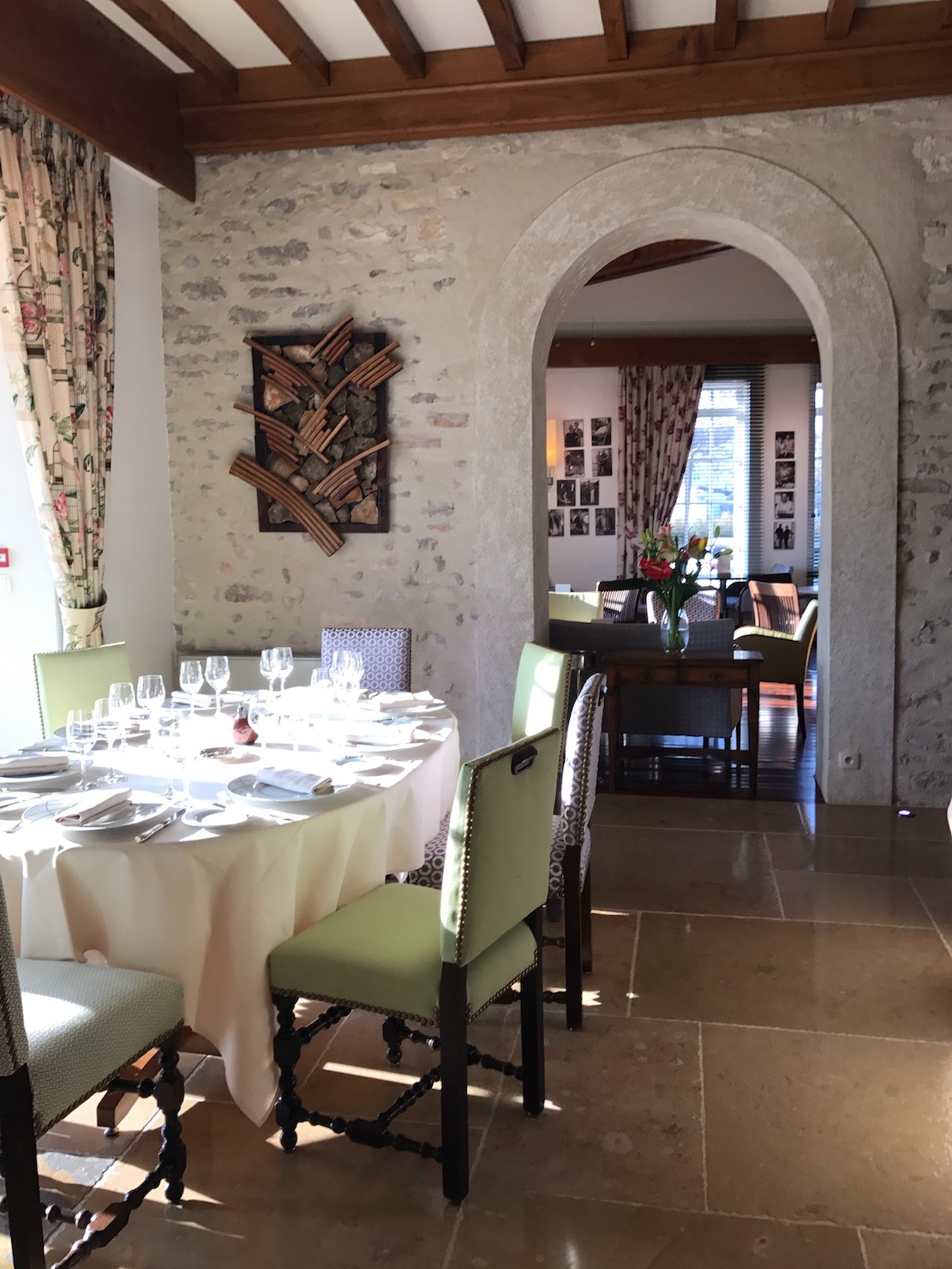
Le Montrachet in Puligny-Montrachet
The plan was to eat our
way to the biennial world chefs championship
called the
Bocuse D’Or. Flying non-stop into
Frankfurt makes it easy to get to eastern France
by way of western Germany. It also makes it easy
to tour the Mosel region before hunkering down
for a Michelin-starred road trip.
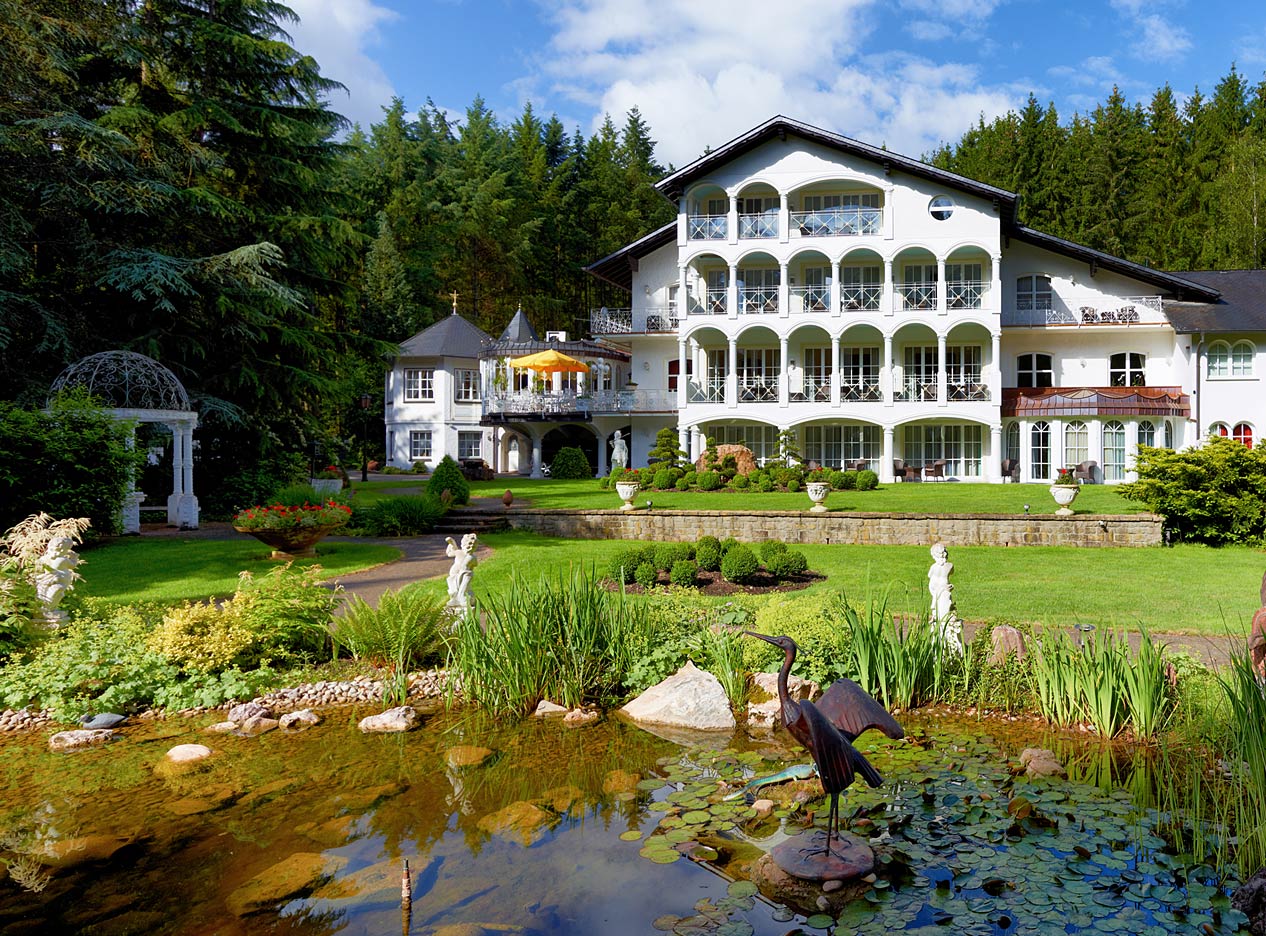 WALDHOTEL
SONNORA
WALDHOTEL
SONNORA
Auf
dem Eichelfeld 1, Dreis, Germany
Tel: 49 6578 406
After a quick stop in Bernkastel
to sip a few current releases at Weinbach Thanisch
Erben-Thanisch, we barreled thirty minutes down
the road to the Waldhotel Sonnora, tucked deep in
the woods between the wine village and the city of
Trier. Unfortunately,
we’d lingered a bit too long with vintner
Sofia Thanisch, so we were a half hour late for
our reservation. Normally, this would not be a big
deal in a three-star Michelin restaurant, deep in
the countryside, on a Saturday afternoon in the
dead of winter. But this was not your average
destination restaurant. This was a German destination
restaurant, and if you know anything about
Germans, you know that they take punctuality very
seriously. (In France they would've shrugged at
our tardiness; in Italy they would've smiled; in
Spain, the chefs wouldn't have arrived for another
hour.)
Calling the Sonnora
picture perfect is an understatement. To get to
it, you wind down a narrow road, a tributary of a
local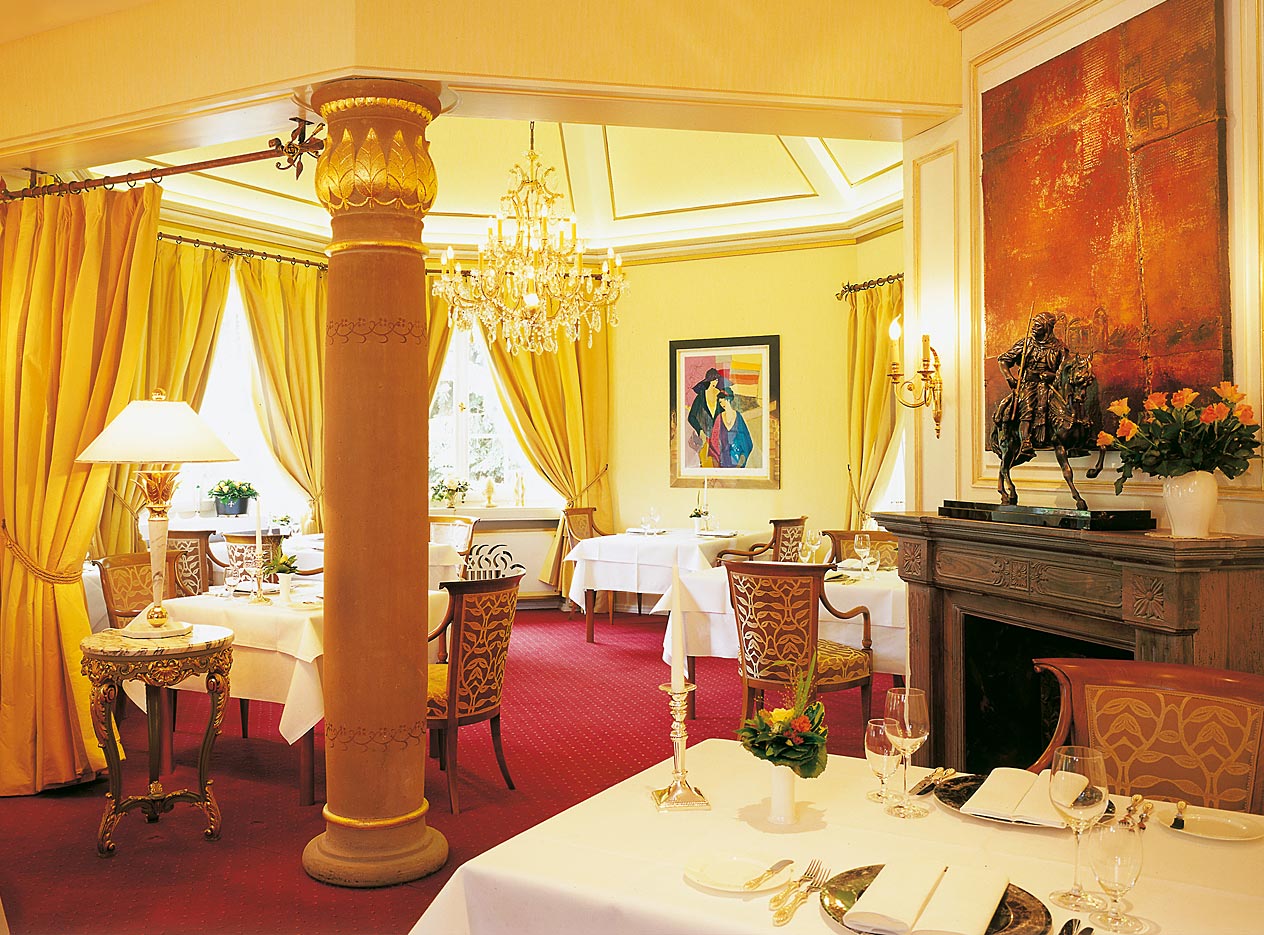 road off
the main highway. Gorgeous conifers and deciduous
trees line the driveway, and in winter you can
imagine yourself entering a storybook land of wood
sprites, apparitions and snow elves. It's about as
cozy as a country inn can get and has the effect
of putting you in the mood for something magical, in this
case the culinary stylings of chef Helmut
Thieltges, who has held three Michelin stars since
1999.
road off
the main highway. Gorgeous conifers and deciduous
trees line the driveway, and in winter you can
imagine yourself entering a storybook land of wood
sprites, apparitions and snow elves. It's about as
cozy as a country inn can get and has the effect
of putting you in the mood for something magical, in this
case the culinary stylings of chef Helmut
Thieltges, who has held three Michelin stars since
1999.
Because of our delay, we were
informed (in a very German, matter-of-fact way),
that all of us would be taking the tasting menu.
"You mean we all have to eat the same thing?" I
asked the proprietress. "Yes, you will order it
and you will enjoy it," she replied. (The only
thing missing was an "Achtung!")
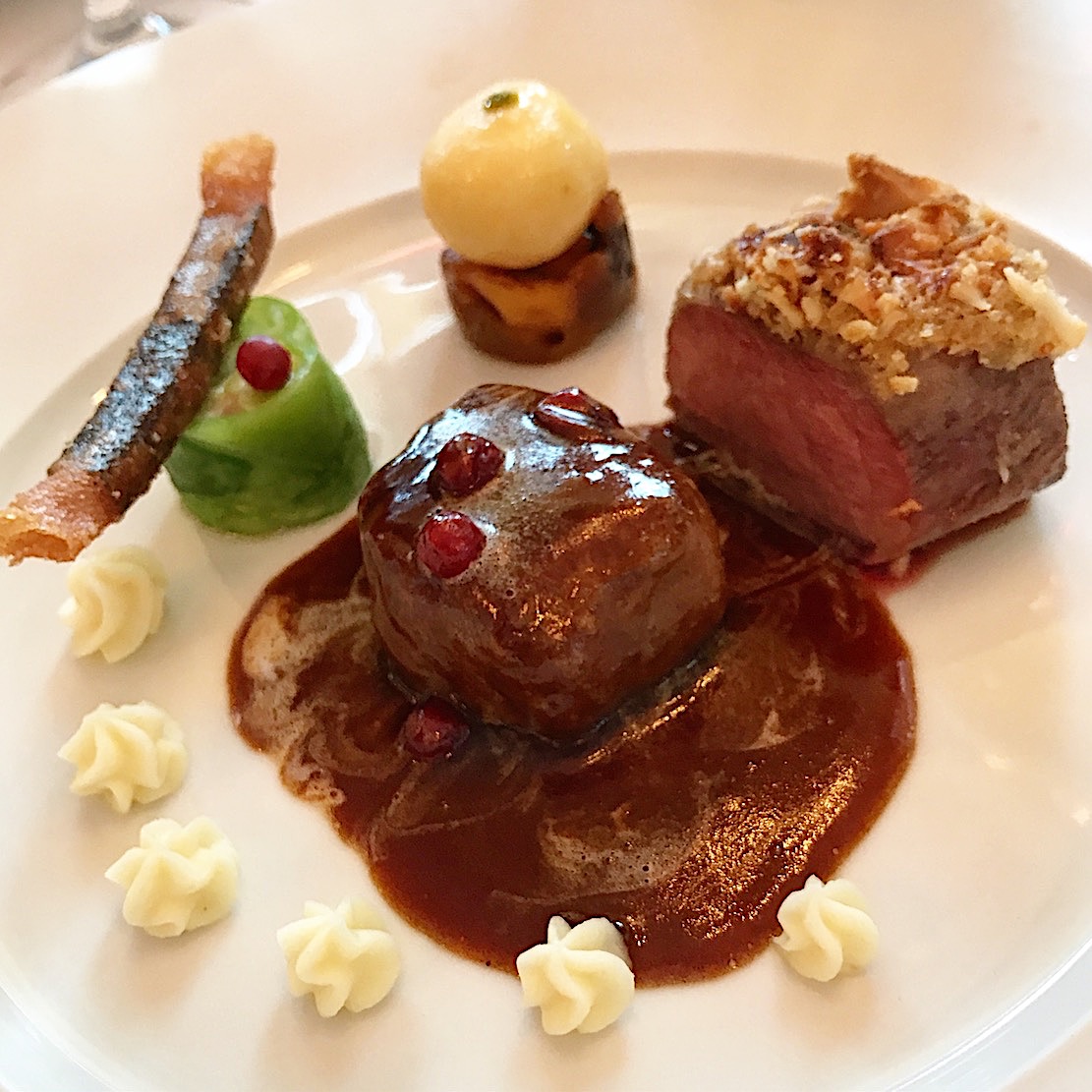 And
thus began our week-long eating adventure. The
food and service at Sonnora were perfectly fine,
but having everyone (five of us) eat the same
thing, at 175 euros a head, for lunch, is not my
idea of an epicurean outing and, figuratively,
left a bad taste in my mouth. What made up for
that taste was a venison dish (left) of
uncommonly rich, wild, gaminess. The menu stated
it came from the Eifel Forest, not far from the
restaurant, and the flavor made you believe it.
This wasn't some namby-pamby deer that tastes of
denatured animal flesh; this was the real deal,
the kind of wild deer hunters live for, gorgeously
enhanced by the wine-laced reduction sauce. It
didn't compensate for my overall disappointment,
but it came close.
And
thus began our week-long eating adventure. The
food and service at Sonnora were perfectly fine,
but having everyone (five of us) eat the same
thing, at 175 euros a head, for lunch, is not my
idea of an epicurean outing and, figuratively,
left a bad taste in my mouth. What made up for
that taste was a venison dish (left) of
uncommonly rich, wild, gaminess. The menu stated
it came from the Eifel Forest, not far from the
restaurant, and the flavor made you believe it.
This wasn't some namby-pamby deer that tastes of
denatured animal flesh; this was the real deal,
the kind of wild deer hunters live for, gorgeously
enhanced by the wine-laced reduction sauce. It
didn't compensate for my overall disappointment,
but it came close.
The venison came on the heels
of a number of noteworthy dishes—a creamy, intense
mussel soup with saffron; a hockey puck of
lacquered goose foie gras; plump scallops
dressed with lemon foam; and a meaty rectangle of
sea bass sitting atop green ribbons of thickened
olive oil-balsamico vinaigrette, each dish a
high-wire cooking act displaying the precision and
balance you expect from a top flight kitchen.
The
service was equally precise, and the wines, Egly-Ouriet
champagne, J.J. Prüm Kabinett Riesling, Roblet
Monnot Bonnes Mares Burgundy, were wonderful, as
was the selection of schnapps offered. And those
wines were a relative bargain: Thanks to the
strong dollar, you can drink very well in the
gastronomic temples of Europe, if you're willing
to spend around 120 euros a bottle.
With a setting right out of a
fairy tale, a knowledgeable staff, and garden
gnomes aplenty to bring you luck, it's hard not to
be charmed by the Sonnora. We didn't feel rushed,
exactly, but the setting was a lot more relaxing
than the meal. Next time, we'll try to show up on
time.
LE SAUVAGE
64 Rue
Monge, Dijon, France
Tel: 33 3 80 41 31 21
After a night in Trier, it was off
to Burgundy, three hours south by car. I had
always wanted to see Dijon, but quickly found that
winter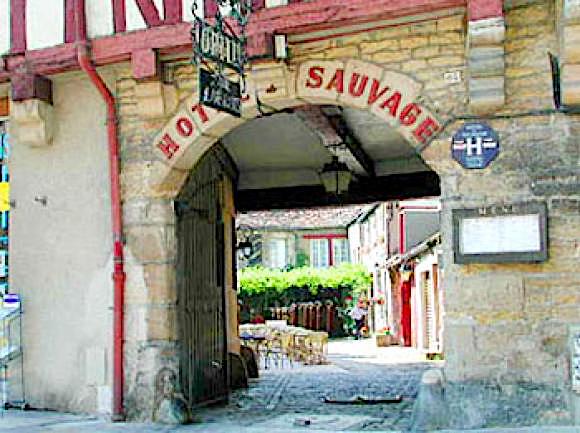 is not when this
classic medieval city shows its best. Mostly, it
just seemed deserted and dingy, but our overnight
stay was salvaged by an incredible cut of beef. Guy
Savoy once told me that he didn't serve any beef
in his
is not when this
classic medieval city shows its best. Mostly, it
just seemed deserted and dingy, but our overnight
stay was salvaged by an incredible cut of beef. Guy
Savoy once told me that he didn't serve any beef
in his 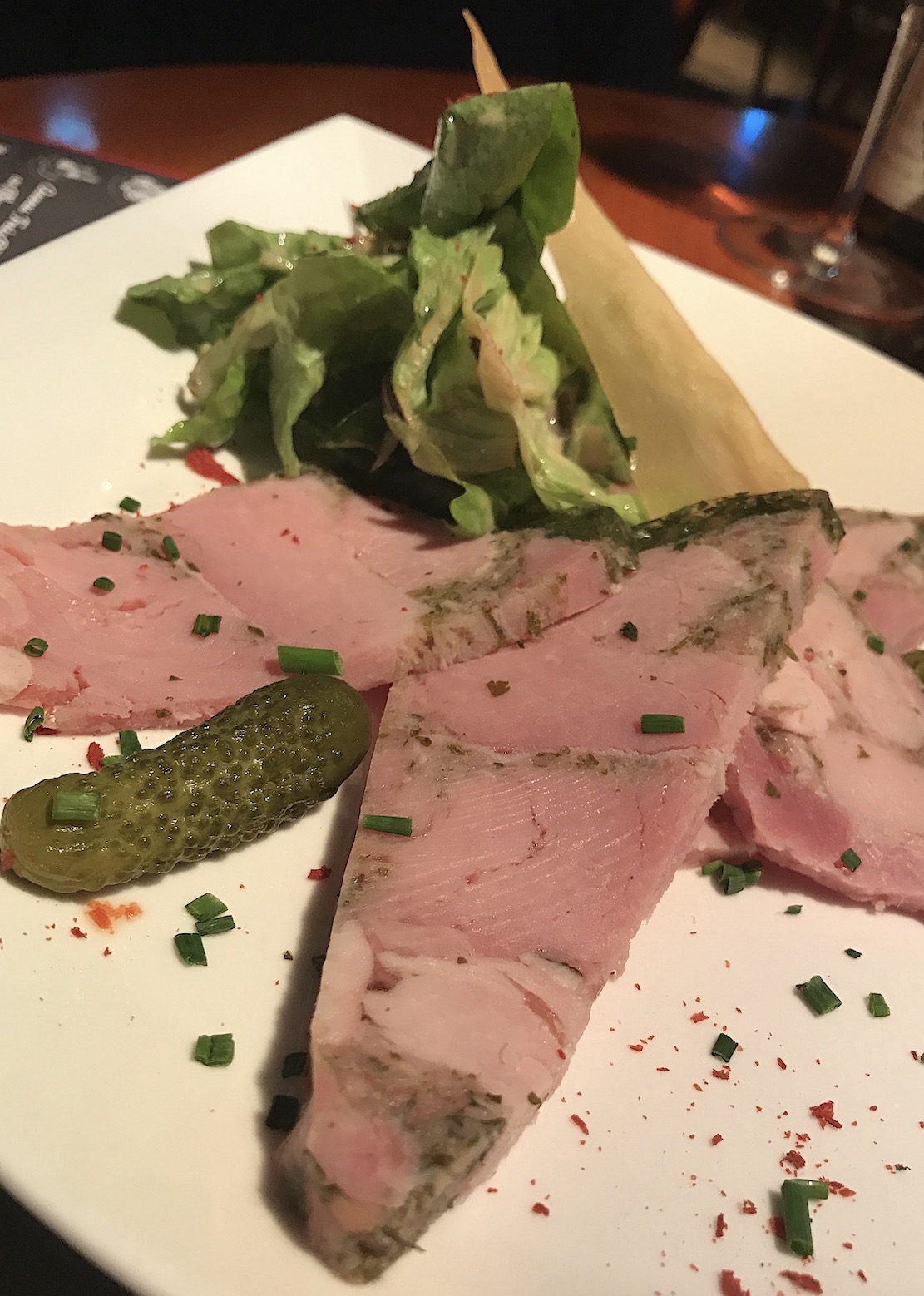 restaurants
in Paris because he didn't like French meat. I
love Guy Savoy, but after tasting a local
Charolais côte
de boeuf at Le Savauge in downtown Dijon,
I think he needs his head examined. The grain may
not have been as fine and supple as some wagyu and
American beef, but the char was perfect and the
flavor was a knockout. It was every bit the equal
of any steak I've had in America—rich, dense and
almost sweet with intense beefiness.
restaurants
in Paris because he didn't like French meat. I
love Guy Savoy, but after tasting a local
Charolais côte
de boeuf at Le Savauge in downtown Dijon,
I think he needs his head examined. The grain may
not have been as fine and supple as some wagyu and
American beef, but the char was perfect and the
flavor was a knockout. It was every bit the equal
of any steak I've had in America—rich, dense and
almost sweet with intense beefiness.
Dijon may not have impressed, but this
restaurant was a treat—an informal atmosphere with
an open grill, a superior wine list and one of the
best steaks of my life (58 euros for a gigantic
steak for two).
The jambon
persillé (left)
was trés
magnifique as well, as was the frisée
salad—it being "garnished" with thick rounds of
Époisses cheese the size of a walnut. In all, a
fabulous little find in dreary old Dijon, thanks
to the concierge at the Hotel Woodrow Wilson.
LE MONTRACHET
10 place du Pasquier de la Fontaine
Puligny-Montrachet
Tel: 33 3 80 21 30 06
It has often been
posited that the reason French food is so good is
because the wines are so good. Or maybe it's vice
versa. 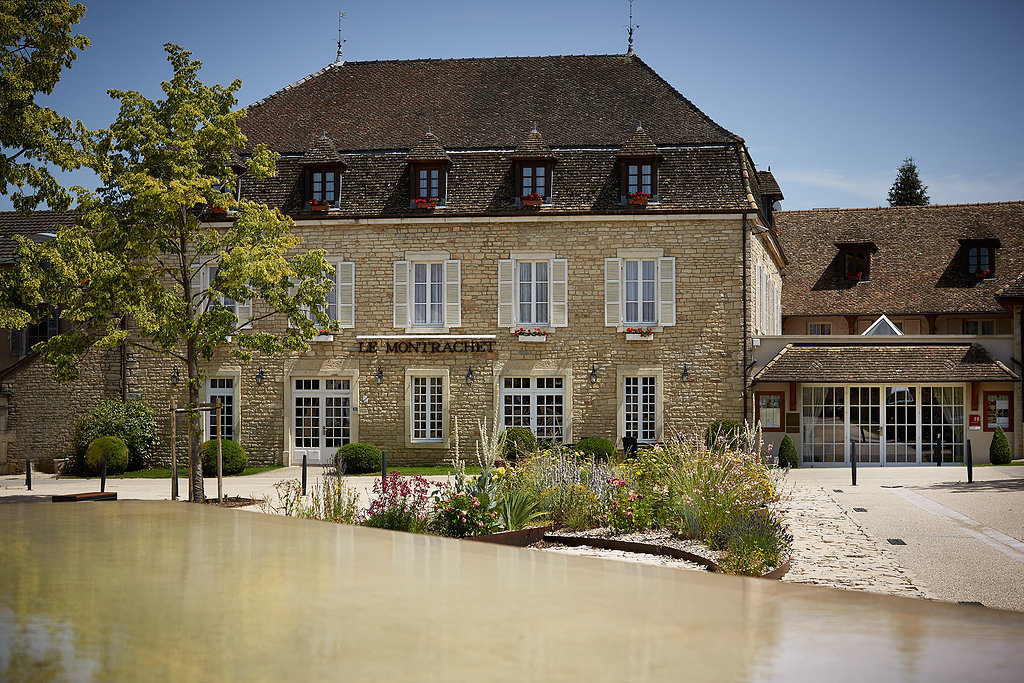 However
you slice it, it's no coincidence that France's
most iconic cuisine begins at Dijon's doorstep,
which is exactly where the great vines of Burgundy
begin to grow. When you dine at Le Montrachet, you
feel as if you’re eating in the center of the wine
universe. The restaurant is part of a small inn
tucked on one side of the town square in the
village of Puligny-Montrachet. Surrounding you are
the vineyards of the greatest white wines in the
world, and the signs (Montrachet,
Chassagne-Montrachet, Puligny-Montrachet,
Meursault) clip by with the kilometers as you
drive down the Route des Grand Crus, or turn up
into the villages that host these iconic
vineyards.
However
you slice it, it's no coincidence that France's
most iconic cuisine begins at Dijon's doorstep,
which is exactly where the great vines of Burgundy
begin to grow. When you dine at Le Montrachet, you
feel as if you’re eating in the center of the wine
universe. The restaurant is part of a small inn
tucked on one side of the town square in the
village of Puligny-Montrachet. Surrounding you are
the vineyards of the greatest white wines in the
world, and the signs (Montrachet,
Chassagne-Montrachet, Puligny-Montrachet,
Meursault) clip by with the kilometers as you
drive down the Route des Grand Crus, or turn up
into the villages that host these iconic
vineyards.
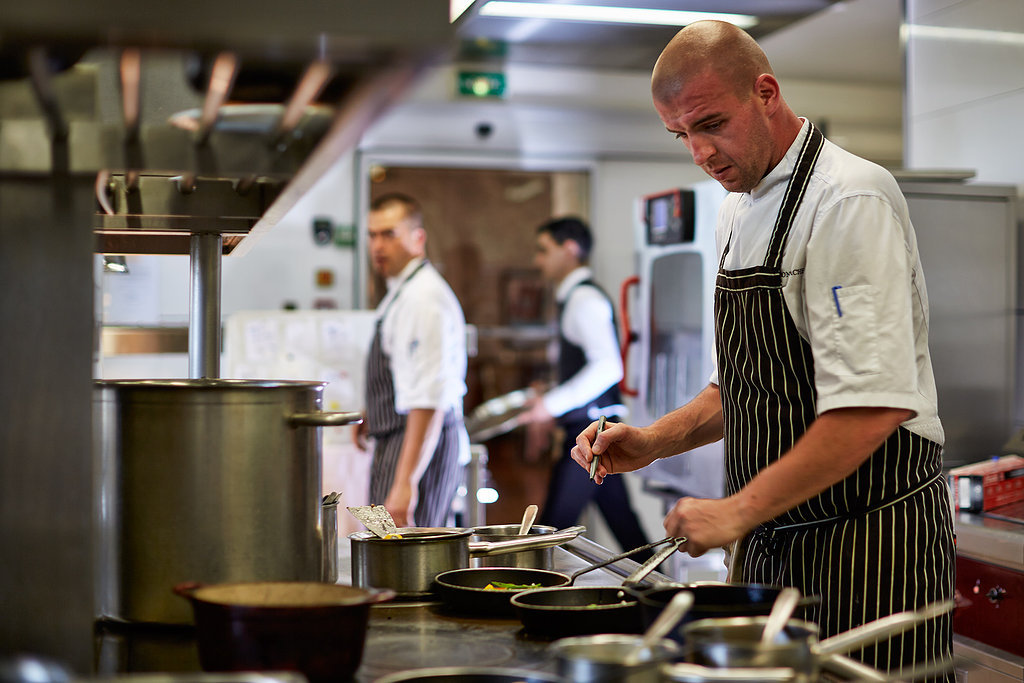 As
charming as these villages are, good restaurants
are few and far between. Le Montrachet came highly
recommended and proved the perfect spot for a
midday repast after hiking around famous vineyards
in sub-freezing weather. This being white wine
country (the famous reds of Vosne-Romanée,
Chambertin and Nuit-Saint-Georges are made about
12 miles to the north), we settled on the Les
Jardins de Puligny menu, which, at 64 euros for
five courses, including cheese, was a steal.
As
charming as these villages are, good restaurants
are few and far between. Le Montrachet came highly
recommended and proved the perfect spot for a
midday repast after hiking around famous vineyards
in sub-freezing weather. This being white wine
country (the famous reds of Vosne-Romanée,
Chambertin and Nuit-Saint-Georges are made about
12 miles to the north), we settled on the Les
Jardins de Puligny menu, which, at 64 euros for
five courses, including cheese, was a steal.
This is hearty Burgundian fare—pâté de campagne,
squash soup, torchon of foie gras, guinea hen
with lentils—lightened by a 21st century chef's
touch; food paired perfectly with a mid-weight,
earthy Aloxe-Corton and a Puligny-Montrachet from
Vincent Giradin.
And then, of course, were the cheeses
course, all local, all unpasteurized, each one
having that deep, animal funk that comes from the
earth and gets lost in the voyage across the pond. Le
Montrachet is not especially fancy or formal, but
it is exceptionally of-its-place, and its one
Michelin star is well-deserved for a great lunch
amidst the world's greatest vineyards.
MASTER FRENCH CHEF
ALAIN SENDERENS DIES AT 77
By John Mariani
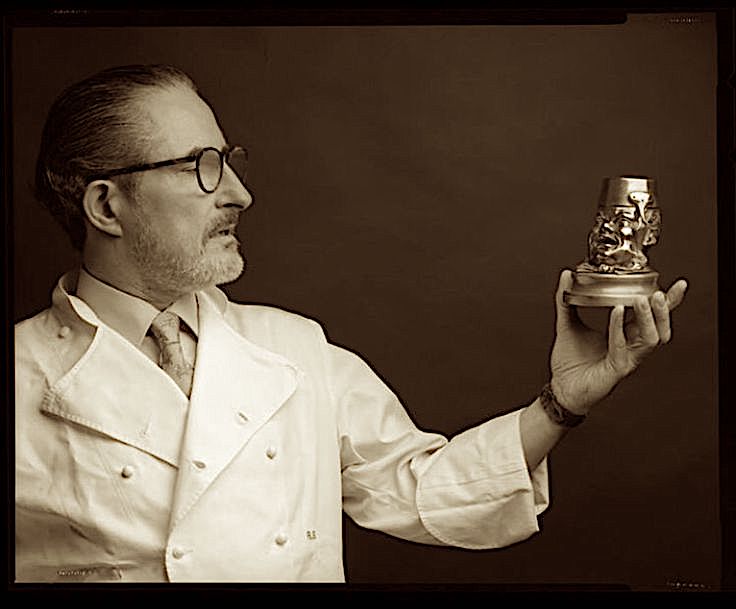
One of the finest originators of France’s la nouvelle
cuisine, Alain Senderens, died last week
at the age of 77 at his home in southwest
France.
Among his colleagues he was universally
respected and was mentor to some of France’s
next generation of great chefs.
Senderens was not so much an
iconoclast—he never betrayed the principles of
classic French cuisine—but when he introduced
dishes like lobster with vanilla sauce and roast
duck Apicius (a dish from ancient Rome), he was
considered among the true innovators of the
movement called la nouvelle
cuisine that began in the late 1960s. La nouvelle
cuisine was never doctrinaire and was many
things to many people; the accepted rubrics of the
movement, which encompassed everyone from Paul
Bocuse and Michel Guérard to Alain Chapel and
Roger Vergé, were to simplify menus, respect
regionality, buy only the finest seasonal
ingredients and to take heed of their guest’s
health, although the idea of la nouvelle
cuisine being
much lighter than traditional French cuisine was
only a small part of the movement.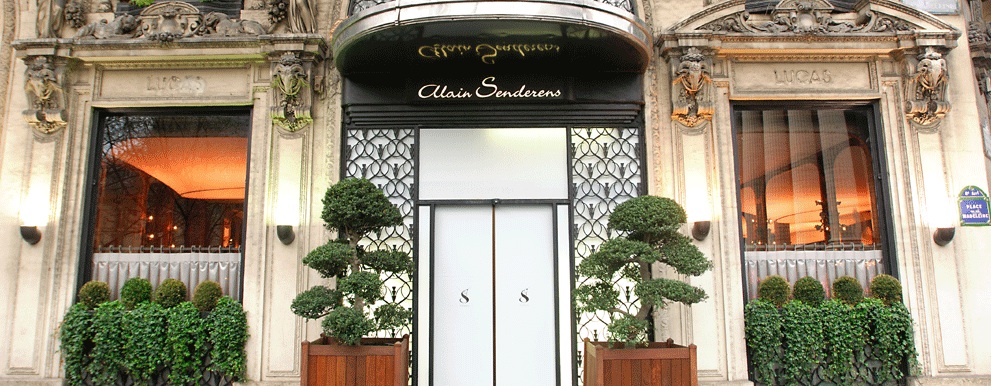
I met Senderens twice, once
when he consulted on a restaurant (briefly) in New
York and again in 2012, towards the end of his
career in Paris, where he had taken over the
legendary Lucas Carton (opened in 1925) on the
Place Madeleine. His own first restaurant, named
L’Archestrate, opened in Paris in 1968, when he
was in his heyday.
He closed that Michelin three-star flagship
in 1985 to go to Lucas Carton, where he maintained
the restaurant’s three stars. There he
introduced the concept of wine pairings with
each dish.
Then,
in 2005, he shocked gastronomes worldwide when he
chose to “return” those stars—Michelin refused to
accept them back—downscaled the restaurant’s
décor, changed its name to Senderens, and charged
100 euros for a meal—less than half what it was at
Lucas Carton. "I feel like
having fun," he told the NY Times.
“I don't want to feed my ego anymore. I am too old
for that. I can do beautiful cuisine without all
the tra-la-la and chichi, and put the money into
what's on the plate."
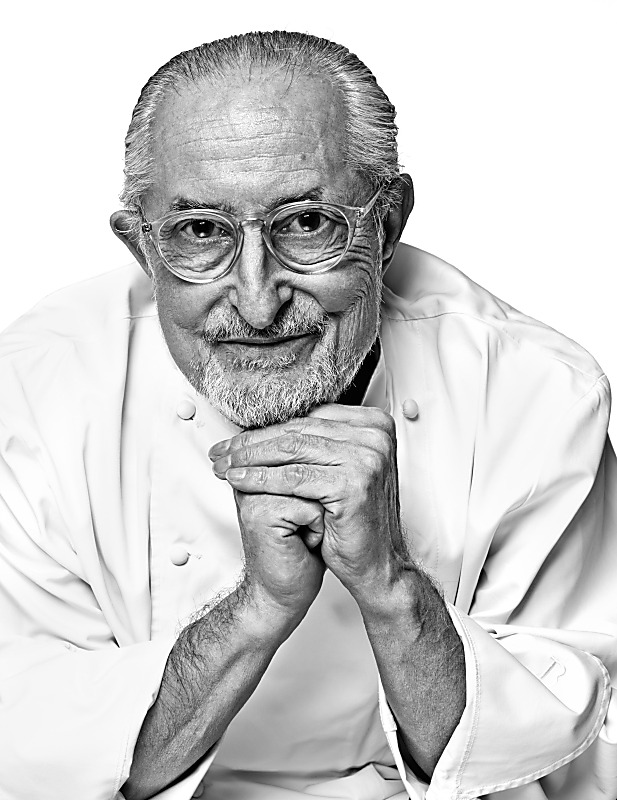 On meeting
Senderens at his namesake in Paris, I found him
extremely affable, despite elementary English, and
still very excited about new ideas for his menus. I
remember enjoying an appetizer of foie gras with fava
beans and wonderful bread, and a variation on his
lobster with vanilla—open ravioli and lobster
flavored with vanilla, served with spinach.
On meeting
Senderens at his namesake in Paris, I found him
extremely affable, despite elementary English, and
still very excited about new ideas for his menus. I
remember enjoying an appetizer of foie gras with fava
beans and wonderful bread, and a variation on his
lobster with vanilla—open ravioli and lobster
flavored with vanilla, served with spinach.
A more classic side was shown impeccably
with a rabbit à la royale,
as well as squab with corn and a puree of
peas. Scallops came with glazed turnips and
the crunch of hazelnuts.
The desserts included a mousseline of
pumpkin with vanilla jelly and bourbon ice cream,
lemon zest and "chips" of pumpkin, as well as "pom. . . pom.
. .pom," a dessert of apple confit, cooked
very slowly, and roasted in wine.
In retrospect, I now think that
Senderens’s best contribution to French gastronomy
was not in those innovations of the 1970s but in
using his name to promote the idea that haute
cuisine had indeed become too haughty, with not
enough clientele to support it. That
idea paved the way for many of his three-star
colleagues to open their own bistros and
brasseries (which, ironically, made them more
money than their three-star flagships) and to stop
agonizing over whether next year the draconian Michelin Guide might
take away a star.
Throughout
his career Senderens was about loosening things up
in French cuisine, nudging not pushing, winking
not declaiming, and always showing concern that
his guests truly enjoyed their experience. The
older
he grew the younger his attitude became, and that
made him a very lucky man.
❖❖❖
By John Mariani
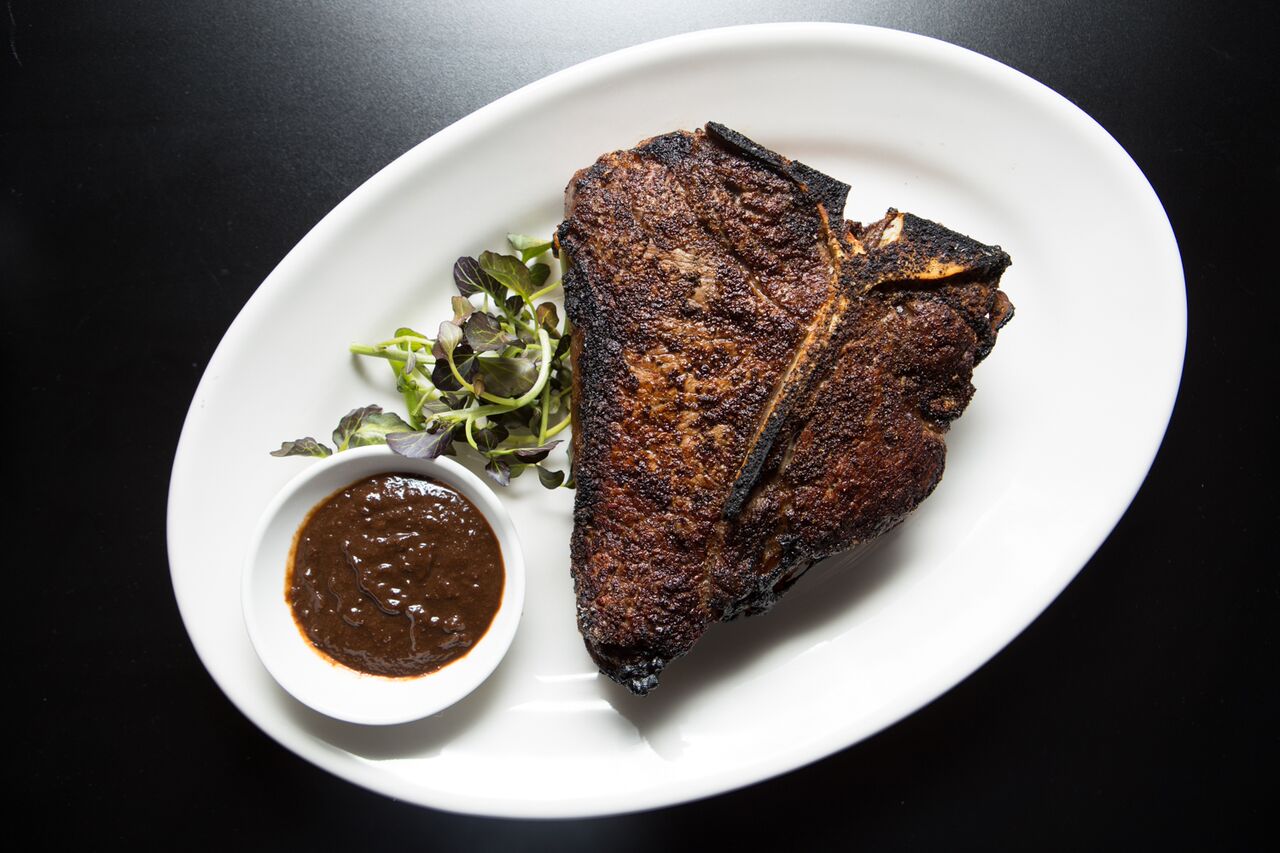
116 East 60th Street (near Park Avenue)
646-893-0160
Back in 1774 John Adams
remarked of New Yorkers, “They talk very
loud, very fast and altogether. If
they ask a question, before you can utter
three words of your answer they will break
out upon you again and talk away”—this from
one of the great loudmouths of the American
Revolution.
But
Adams was right, and it’s no different today. New
Yorkers feel the need to talk at the top of their
lungs and nowhere is this more evident than at
most NYC steakhouses, including in the lounge area
up front at the year-old Blu on Park, set in a
1920s East Side brownstone. Push
beyond that, however, and, after the bar crowd
staggers out around 7:30, you’ll find yourself in
a somewhat refined two-story dining room done
mostly in hues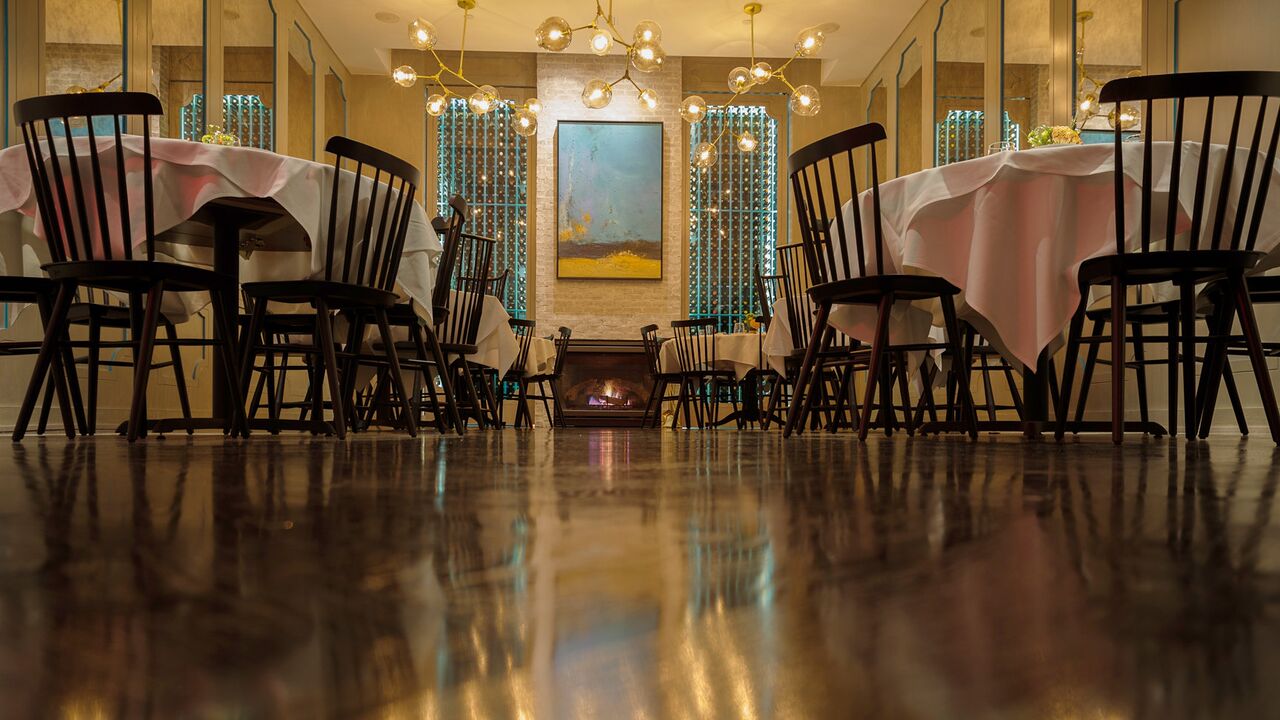 of gray
and dark brown, with a shimmering wine wall to the
rear and widely set, capacious tables set with
white linens lighted by clear glass bulb
chandeliers.
The decibel level drops to a courteous
level, and my request to turn down the unnecessary
booming music was granted immediately.
of gray
and dark brown, with a shimmering wine wall to the
rear and widely set, capacious tables set with
white linens lighted by clear glass bulb
chandeliers.
The decibel level drops to a courteous
level, and my request to turn down the unnecessary
booming music was granted immediately.
On
my first visit a year ago I found the steaks at
Blu on Park (heavens knows why they dropped the
“e”) of very high quality, but much of the rest of
the menu was lackluster and the service
amateurish.
These days new Executive Chef Rory
O’Farrell has 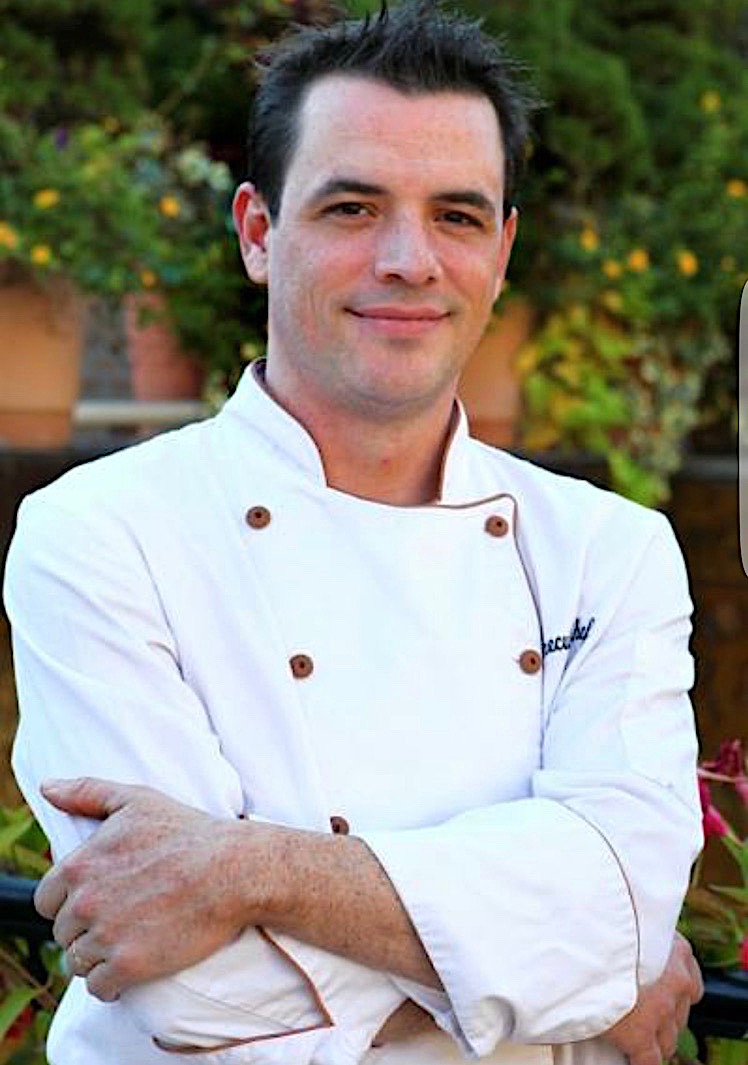 maintained
the high quality of the beef while elevating
everything else on the menu, so that the once
chintzy crabcake may now be the best in the
city—true jumbo lump with next to no binder ($22). More on
service in a moment.
maintained
the high quality of the beef while elevating
everything else on the menu, so that the once
chintzy crabcake may now be the best in the
city—true jumbo lump with next to no binder ($22). More on
service in a moment.
Other straightforward
appetizers include a moist tuna poke tartare with
cucumber, radish, mango coriander, red onion, and
a mango yuzu vinaigrette that really brightens the
flavors ($22), and a roasted beet salad with
caramelized goat’s cheese and a balsamic glaze
($14). Colorfully arranged hamachi
crudo was equally as impressive. Sautéed jumbo tiger
shrimps with baby spinach,
baked polenta and a tangy lemon-garlic dressing
were meaty, sweet and delicious ($36).
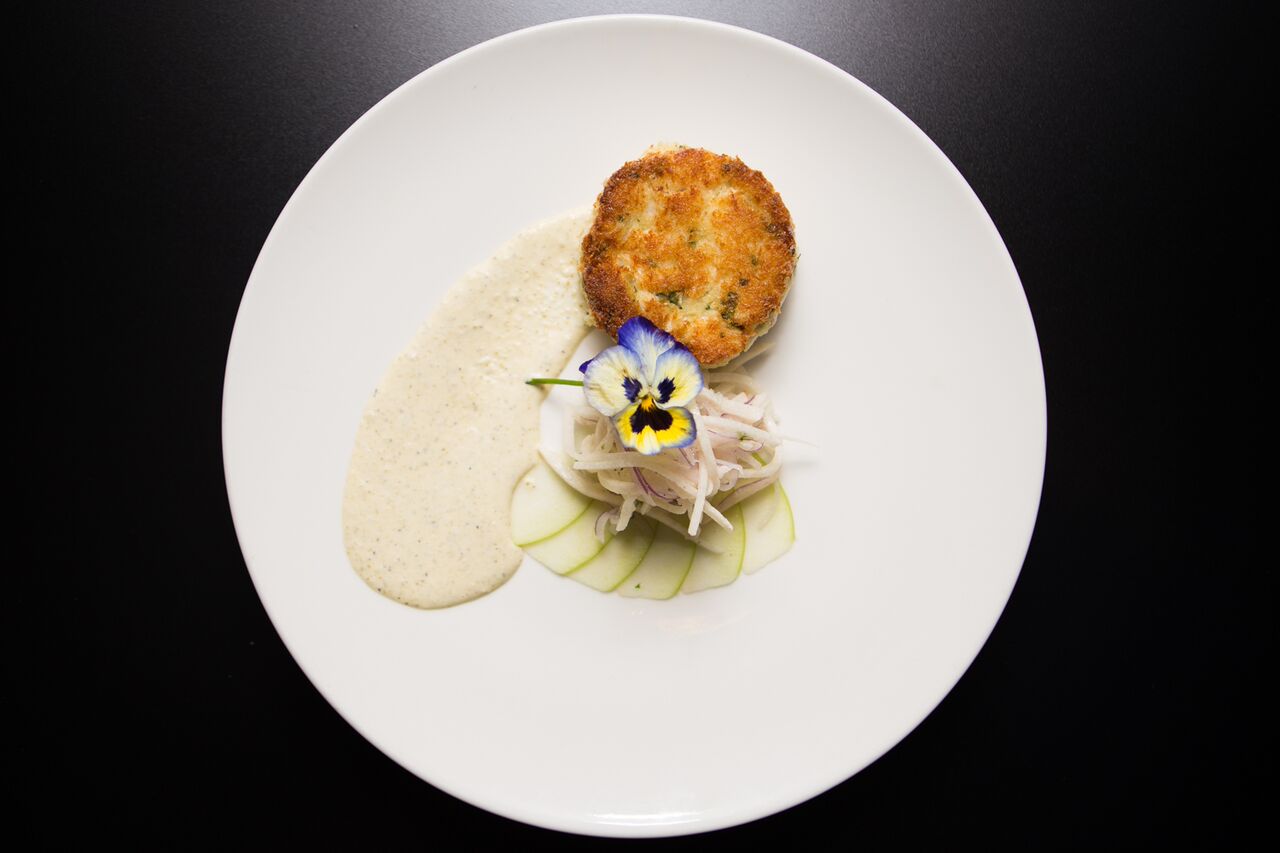 Back to the beef: Buying top
quality is crucial for a NYC steakhouse, but
knowing how to cook it
is as well.
Too often the exterior hasn’t enough char
(unless the guest asks for it to be lightly
seared); at
Blu it gets a true, sizzling crust that combines
fat and caramelization, yielding beautifully rare
or medium-rare, well-marbled meat beneath and just
enough oozing juices to add to its magnificence. Blu’s
is one of the best steaks I’ve had in Manhattan in
a while, and I’ve had plenty of very good ones.
Back to the beef: Buying top
quality is crucial for a NYC steakhouse, but
knowing how to cook it
is as well.
Too often the exterior hasn’t enough char
(unless the guest asks for it to be lightly
seared); at
Blu it gets a true, sizzling crust that combines
fat and caramelization, yielding beautifully rare
or medium-rare, well-marbled meat beneath and just
enough oozing juices to add to its magnificence. Blu’s
is one of the best steaks I’ve had in Manhattan in
a while, and I’ve had plenty of very good ones.
You
can get a sweetly-marbled ribeye ($49), a tomahawk
(below)
for two ($99), a filet mignon ($52), porterhouse
cut for two to four ($50 pp), or a hefty NY
sirloin ($48), all offered with a variety of
sauces. I
also recommend the lamb chop ($48) with goat’s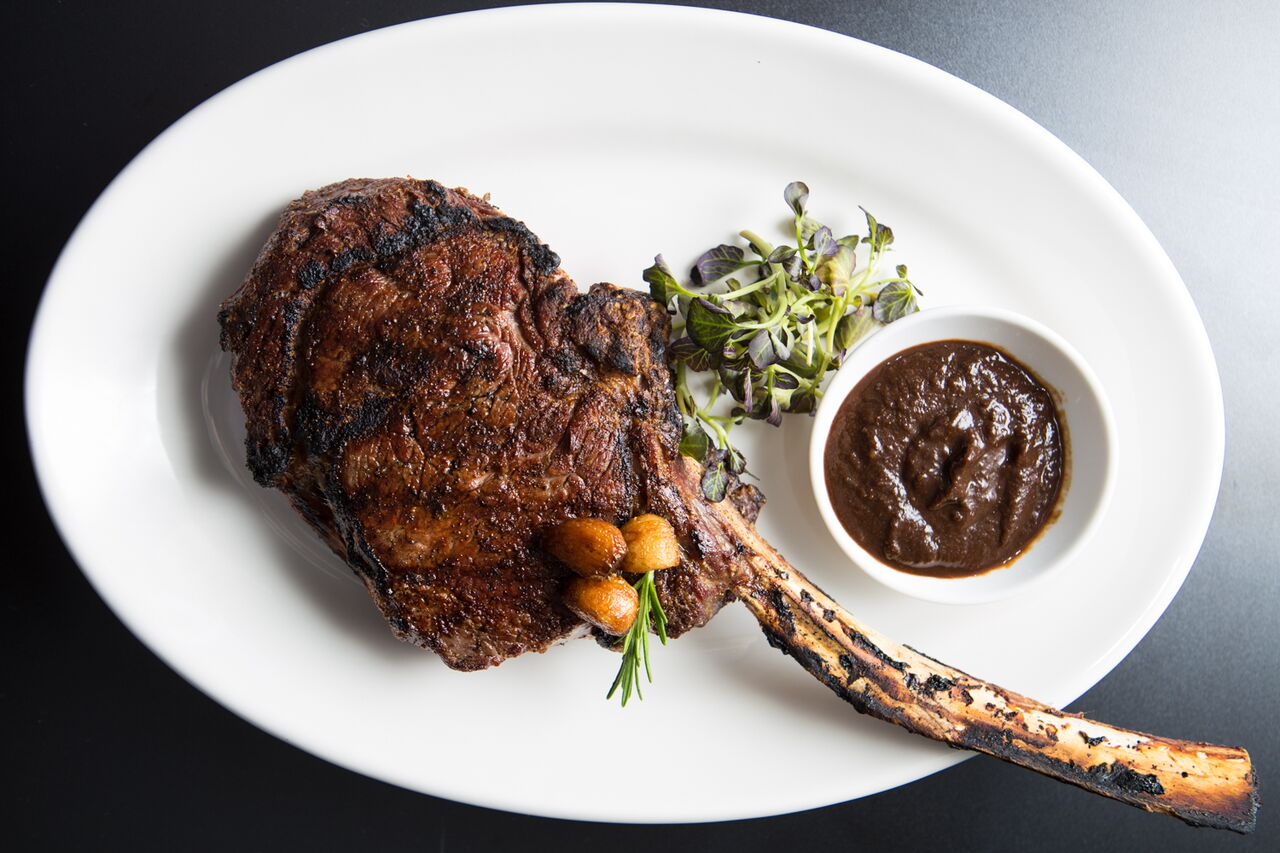 cheese-drenched macaroni and baby arugula. Lobsters
are offered at market price.
cheese-drenched macaroni and baby arugula. Lobsters
are offered at market price.
All the sides are ten bucks,
including pan-roasted Brussels sprouts, rich
creamed spinach, hand-cut French fries and
generously buttered mashed potatoes.
If you’ve got the room, split a
classic Jewish-style sour cream cheese cake with
macerated strawberries ($12) or a double chocolate
mousse with raspberry gelée ($12).
The wine list is not among the
top screeds in NYC but is more than adequate for
this type of fare.
Prices are steakhouse high.
Service is still a problem. Last
year it was spotty and it still is. After
we ordered and received first courses, the few
staff members in the dining room seemed to
disappear and were hard to flag down. Also a
mix-up in ordering resulted in the wrong dishes
served or forgotten entirely until reminded. Blu has
a ways to go in this department at a time when the
traditional brusque steakhouse waiter has,
thankfully, become something of a dinosaur.
Blu on Park deserves attention for
the quality of the food and an atmosphere that
contrasts with the boisterous hyper-macho tone of
most competitors.
Just get the service in synch and this
would rank even higher.
Blu on Park is open for lunch and
dinner daily, and brunch on the weekends, with
the addition of jazz every Sunday.
❖❖❖
INDUSTRY TO BORDEAUX
By John Mariani
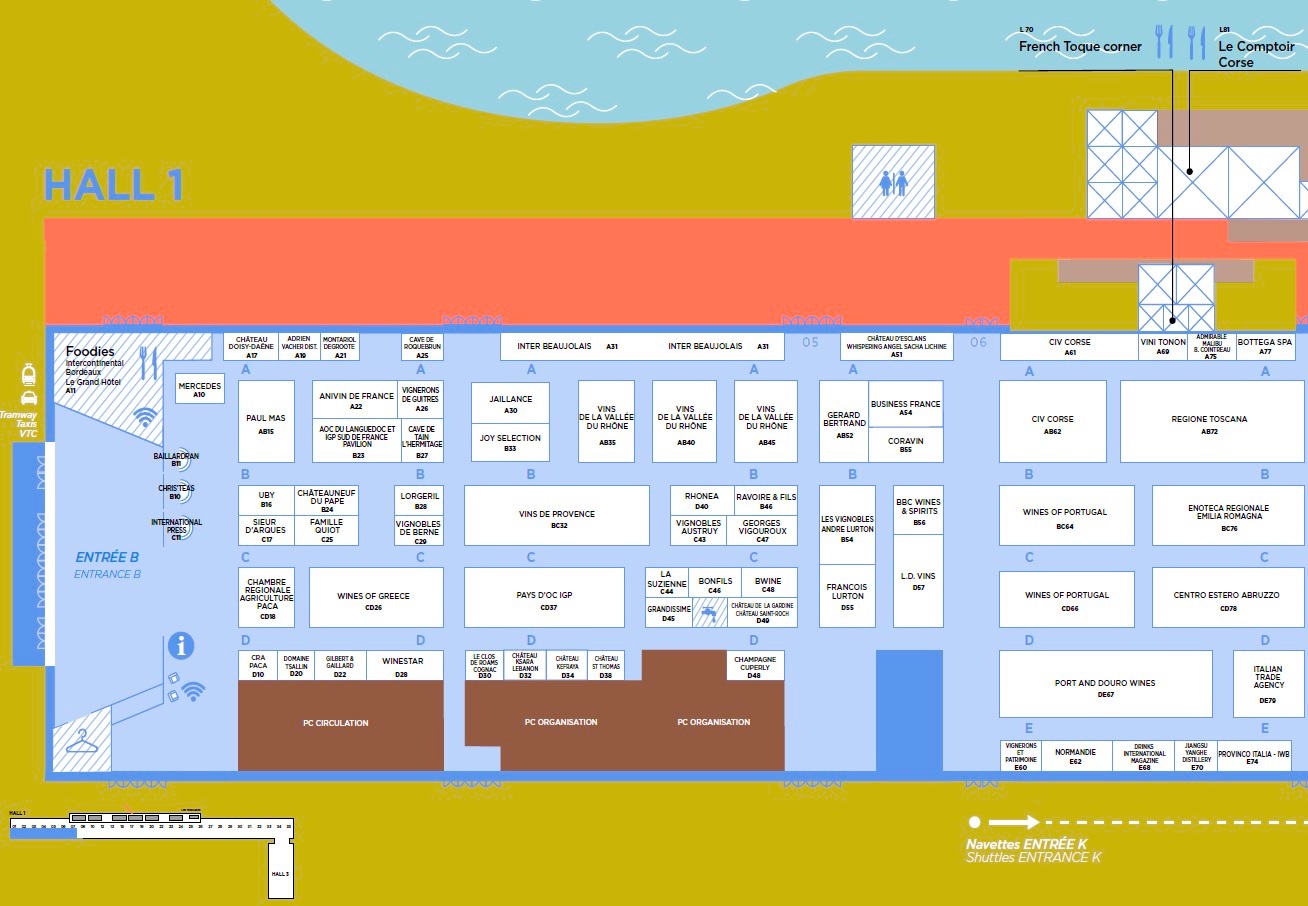
The
graphic above shows but one hall connected to
many in the vast Parc des Expositions in
Bordeaux, where the 2017 VINEXPO show was held
in June as a showcase for the world’s wines
and spirits.
Indeed, walking from one end of the
connected hallways—without stopping and saying
“par-don”
to a
hundred people standing in the aisles—can take
close to fifteen minutes. Along the way tens
of thousands of bottles of wines and spirits
in state-of-the-art lighted stalls make it all
the more dazzling—the proverbial kid in the
candy store reaction—for anyone visiting this
four-day event. It has its glitzy glamour—the
vendors always pick the prettiest girls in
France as hostesses—but it’s even more about
business.
a
hundred people standing in the aisles—can take
close to fifteen minutes. Along the way tens
of thousands of bottles of wines and spirits
in state-of-the-art lighted stalls make it all
the more dazzling—the proverbial kid in the
candy store reaction—for anyone visiting this
four-day event. It has its glitzy glamour—the
vendors always pick the prettiest girls in
France as hostesses—but it’s even more about
business.
Each of the 2,300 exhibitors
from 40 countries comes seeking to attract the
attention of the 45,000 visitors who pour in
from more than 150 countries. (Even
so, VINEXPO is second to VINITALY, held each
spring in Verona, Italy, with 4,100 exhibitors
and 128,000 visitors.)
Some are merchants and
distributors, others restaurateurs and
sommeliers, and—the most prized of all—buyers
from the world’s supermarkets, who might wrangle
deals and sign contracts to buy thousands of
cases. There
were also 1,000 journalists from 50 countries,
including myself, a first-timer at VINEXPO, set
20 minutes by tram from the city of Bordeaux,
which is the center of the wine business in the
region of the same name.
 The
importance of inviting journalists to the event
is for them to afterwards spread the word
garnered from special tastings, seminars,
interviews, and luncheons. This
year, in league with Wine
Spectator, a Taste of Spain event (left) was
held in Bordeaux’s sprawling Palais de la Bourse
to showcase both modern viniculture—Spain was
the Country of Honor this year—and the food by
an array of young Spanish chefs hand-picked by
the master Ferran Adria. Sadly,
a 100-degree heat wave made the un-air
conditioned Palais a bit stifling.
The
importance of inviting journalists to the event
is for them to afterwards spread the word
garnered from special tastings, seminars,
interviews, and luncheons. This
year, in league with Wine
Spectator, a Taste of Spain event (left) was
held in Bordeaux’s sprawling Palais de la Bourse
to showcase both modern viniculture—Spain was
the Country of Honor this year—and the food by
an array of young Spanish chefs hand-picked by
the master Ferran Adria. Sadly,
a 100-degree heat wave made the un-air
conditioned Palais a bit stifling.
Each morning an edition of VINEXPO
Daily appears, detailing the myriad events
of the day and featuring interviews and opinion
on the trends in the global wine world. And
global is the key word. Where once exhibitors
courted U.S. buyers and distributors with high
fervor, equal attention is now being paid to
China, which is set to become the world’s second
largest wine drinking country by value by 2020,
overtaking the U.K. and France.
Discussion
of the Chinese market was paramount throughout
the event, with consumption expected to grow by
nearly 40% over the next three years, to the
tune of $22 billion and 52.7 million cases. In an
article in VINEXPO
Daily, Lei Zhao, director of Fast Moving
Consumer Goods for the Chinese retail
giant Tmall Food, said that China is already the
fourth largest importer of French wine. “China
is a country enchanted by wine,” he insisted.
“After France, Spain, Italy, Australia and the
U.S. are the most important partners. A growing
share of the population, including younger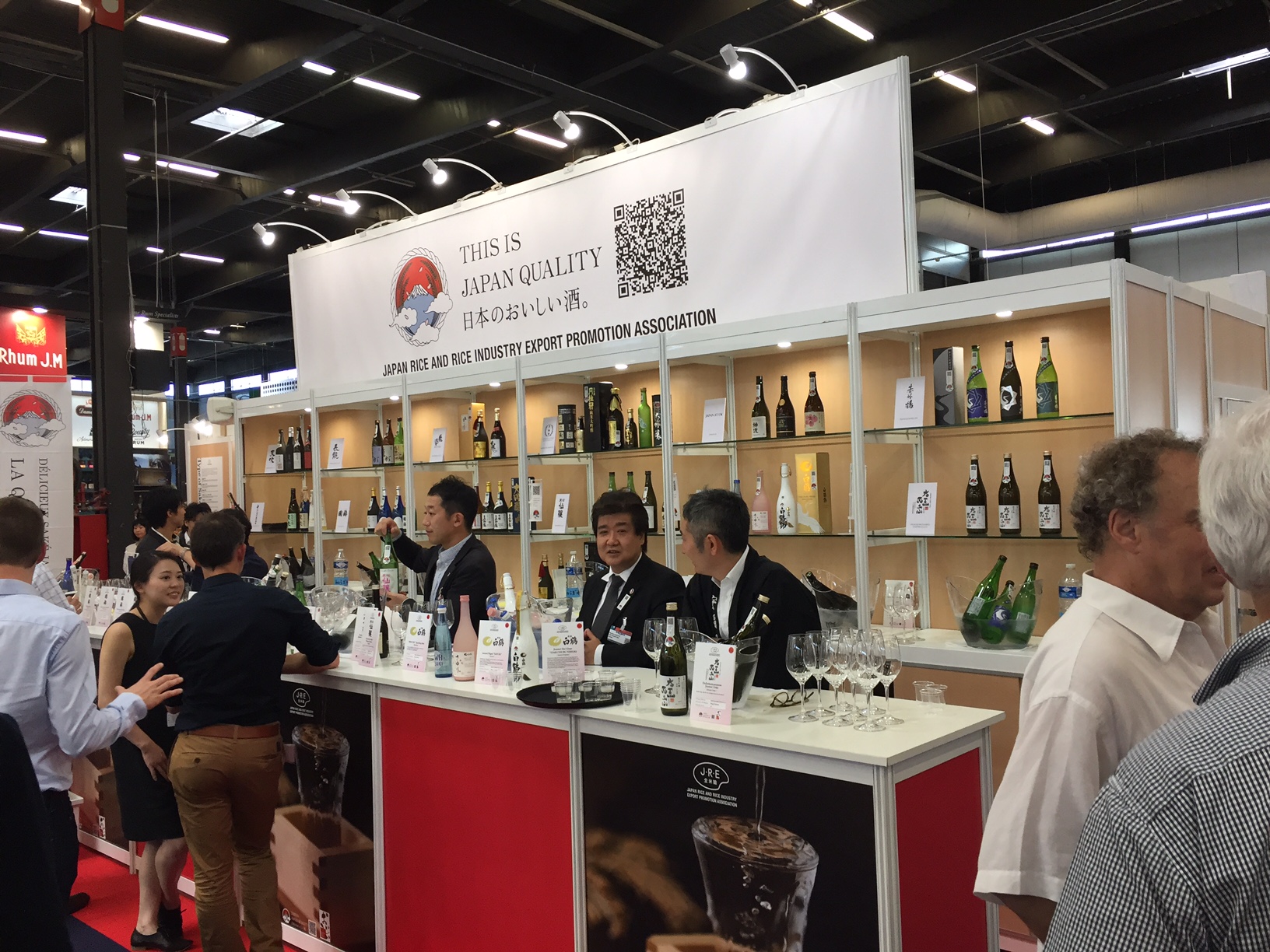 generations, are
refining that taste for wine and becoming more
sophisticated when they choose what to drink.
It’s also a mindset shift, as consumers
understand that wine is great to pair with
food.”
generations, are
refining that taste for wine and becoming more
sophisticated when they choose what to drink.
It’s also a mindset shift, as consumers
understand that wine is great to pair with
food.”
He did advise exporters to
take regional Chinese tastes into consideration
in their marketing: “For example, consumers from
certain parts of China such as the southern
Jiangsu province, tend to appreciate fruity wine
to go with the cuisine, which is founded on
sweeter flavors.”
On another front, Japan is
now Asia’s next largest importer of wines, but
the biggest for imported spirits in the region,
with a 15% growth in spirits in 2015, even as
sake and shochu consumption declines in Japan. But
outside of it, sales are rising, with exports
currently 3% of production, with 50% going to
the U.S. and 25% to Hong Kong. This
year a powerhouse of 28 brewers came to VINEXPO
under the umbrella of the Japan Sake and Shochu
Makers Association, the result of two years of
planning to get to Bordeaux.
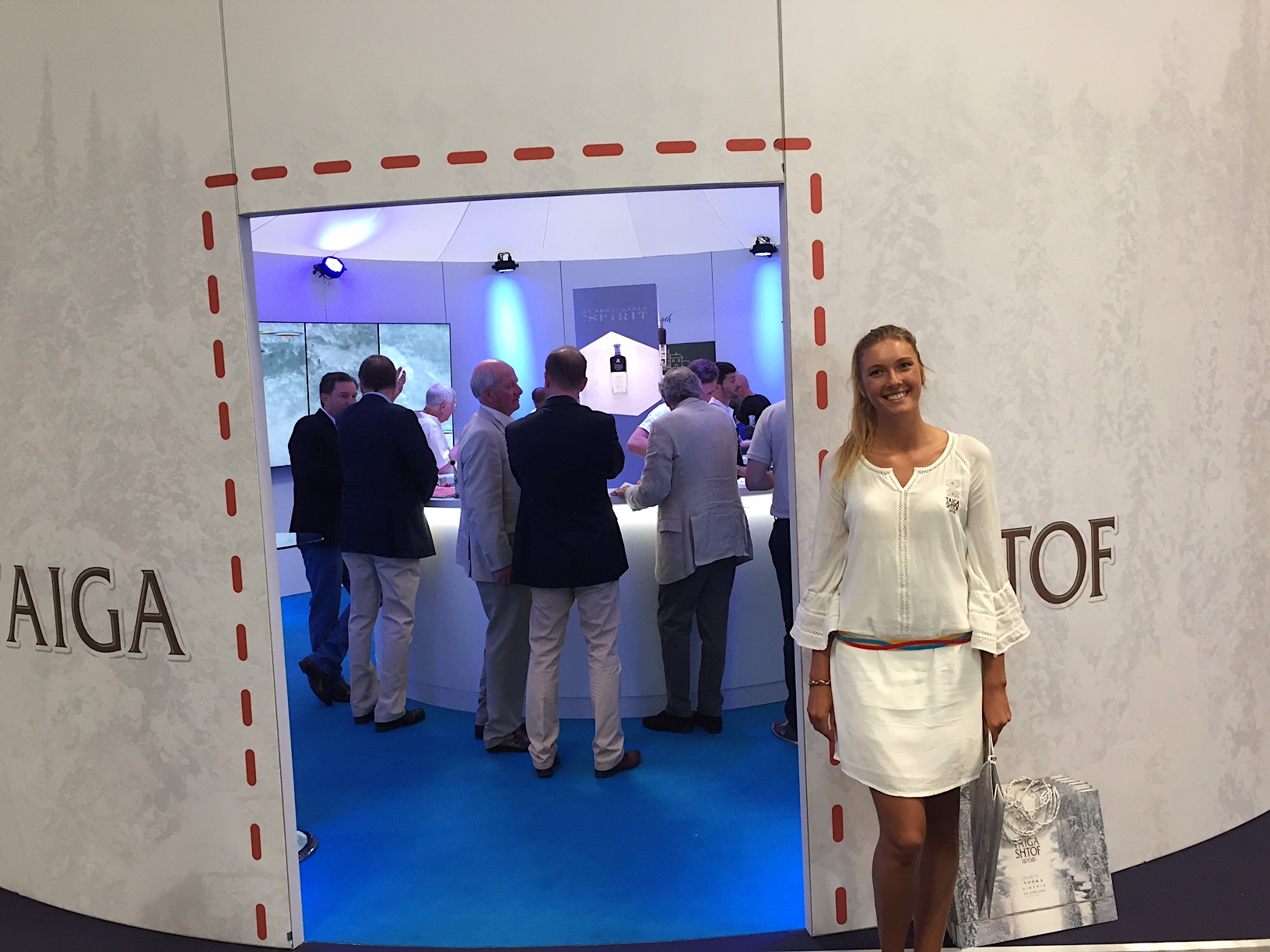 Old
and new products in brand new bottles are rife
throughout the exposition, and there was a
significant promotion of rosé wines by producers
and companies that believe that market will
continue to soar, and not just as summer wines. There
was also a good deal of buzz about the wines of
developing countries like Slovenia and Serbia.
One of the real surprises for me was to find a
new vodka—a category that might seem way
over-represented in the market—called Taiga
Shtof, from Siberia (left), which was far smoother
than any I’ve tasted. It will be in the New York
market this fall.
Old
and new products in brand new bottles are rife
throughout the exposition, and there was a
significant promotion of rosé wines by producers
and companies that believe that market will
continue to soar, and not just as summer wines. There
was also a good deal of buzz about the wines of
developing countries like Slovenia and Serbia.
One of the real surprises for me was to find a
new vodka—a category that might seem way
over-represented in the market—called Taiga
Shtof, from Siberia (left), which was far smoother
than any I’ve tasted. It will be in the New York
market this fall.
The success and sheer size of
VINEXPO—which will also have a smaller version
in Vienna this year, then bring a new event to
New York next March—precludes opening the doors
to consumers.
But for wine professionals it is critical
both to be represented and to check out what’s
new as well as renew old business partnerships. Thus,
you will find most of the finest chateau owners
of France, Italy, Spain and Germany along with
historic vintners like Spain’s Torres and
France’s Mouton-Rothschild, which both have
strong holdings in Chile.
Strolling through the long
aisles at VINEXPO allowed me, as a journalist,
the extraordinary opportunity to stop at
hundreds of stalls of wineries and buyers I know
well along with scores new to me, asking
questions of the owners in attendance. A
Press Center was open for journalists to file
stories and do interviews, and there was a new
area called WOW! devoted to the “World of
Organic Wines.”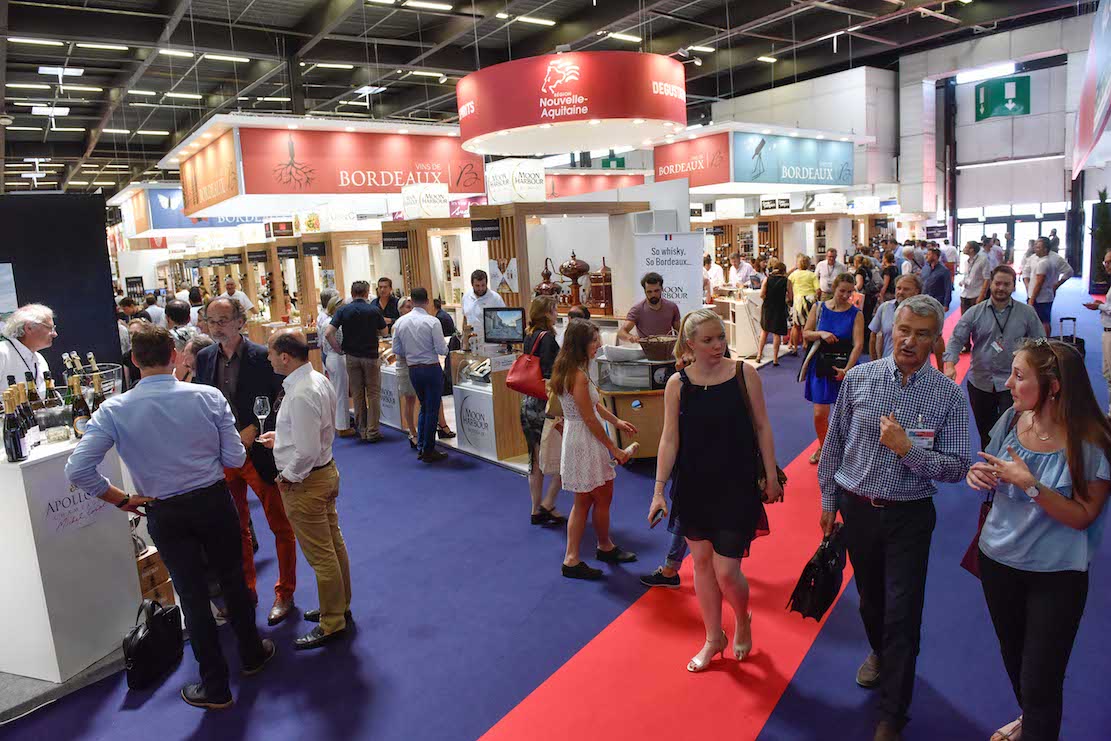
The seminars I attended
ranged from technological—the one on the
concerns of the wine community about global
warming deserves an entire report I will be
writing soon for this newsletter—to talks
dealing with digitalizing wine marketing and
sales.
Tasting as you go along is
part of the pleasure of VINEXPO—the doors open
at 9:30 a.m., when there’s already a line
outside—but can be tough going. This
is in addition to dozens of sit-down tastings
held by wineries and regions, including the Cru
Bourgeois of the Médoc; Sauternes and Barsac;
the Loire Valley; Port and cheese; an “Irish
spirits renaissance;” nine Italian wineries
given Tre Bicchieri awards by Vini
d’Italia magazine; wines fit for banquet
service; a Riesling master class; and Spanish
white wines.
There were also dinners at
Château Mouton-Rothschild and Château Latour I
was privileged to attend, both ending up with
spectacular fireworks displays. More
to come on those evenings.
Much
of what I took away from the four-day event will
find its way into upcoming articles, as soon as
it all settles down into various parts of my
brain, which may be just in time for VINEXPO to
land in New York in 2018.
❖❖❖
'EY,
MATE! FERGOT YER 'OT SAUCE?
A former rapper named Terry "2Pec" Peck (right), who ordered $466 worth of food and alcohol at Omeros Bros Seafood restaurant on Australia's Gold Coast, was arrested after running out on his bill and into the ocean. The police rode out on the water on Jet Skis to coax Peck in, then dragged him ashore and charged him with theft and two counts of seriously assaulting a police officer.
ANNALS OF GREAT COVER LINES
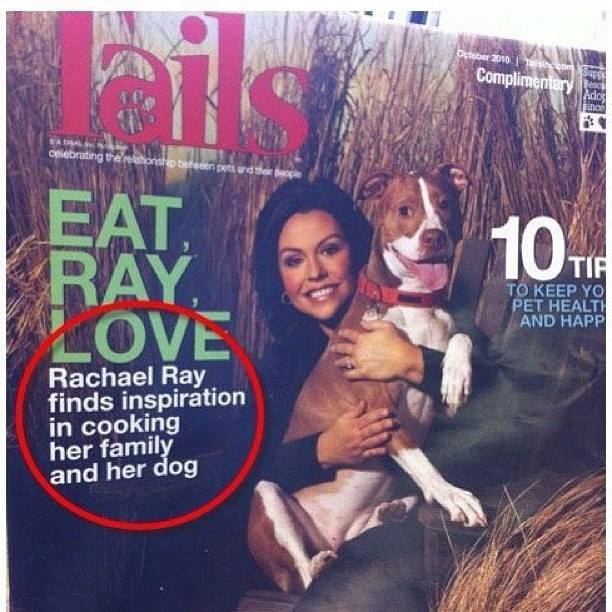
Sponsored by Banfi Vintners
SUMMER IS HERE
AND SO ARE WONDERFUL CHILEAN WINES
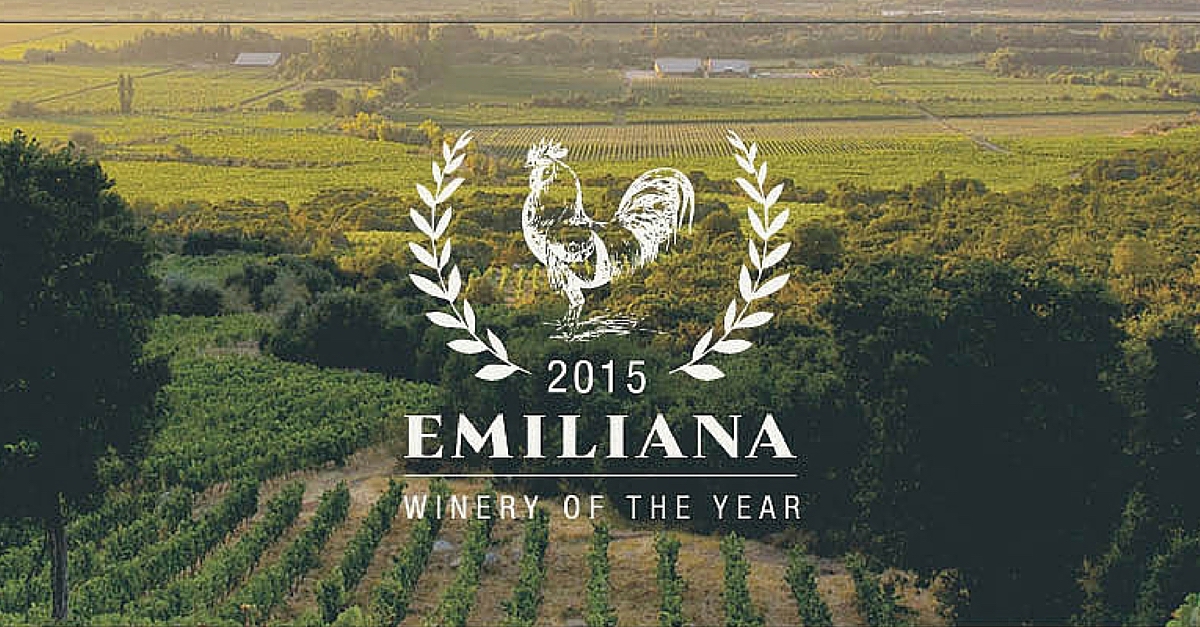
As
Summer finally kicks into gear, we are reminded of the
fragility of Mother Earth and her bounty. As an
importer representing several family wine makers from
around the globe, I often like to point out that all
the wines that we represent are green, some of them
greener than others. The greenest of all are
classified as Biodynamic or certified Organic.
One of the most interesting selections of
eco-balanced, organic and biodynamic wines comes to us
from Chile and the vineyards of
Emiliana.
Emiliana was founded by our
friends, the Guilisasti family, who have a long and
proud history of winemaking with their Concha y Toro
brand. Three decades ago, well ahead of the
curve that has made organic wines all the rage today,
they set up dedicated and, most important for organic
farming, isolated vineyards for this type of
agriculture. Many may picture the small farmer
as being the most “organic,” but in the reality of our
wine world, sometimes it takes the “big guys” to act
as a locomotive to get a movement such as this on
track.
Organic farming is a form of
agriculture which avoids or largely excludes the use
of synthetic fertilizers and pesticides, plant growth
regulators, and livestock feed additives.
Organic farmers rely on crop
rotation, crop residues, animal manures--including
llamas (below)--and
mechanical cultivation to maintain soils productivity
and health, to supply plant nutrients, and to control
weeds, insects and other pests. To call a wine
organic in the US, government regulation says that it
must be produced from 95% organically grown
ingredients with no added sulfites. If you add
sulfites in the relatively minimal amount of 100 parts
per million, you can only say that the wine is “made
from organically grown grapes.” Now, not to go
into a chemistry lesson, but it is virtually
impossible to make a wine without that modest dose of
sulfites, at least if you want to drink it beyond ten
feet of the cellar it was made in and wish it to
survive any moderate amount of aging.
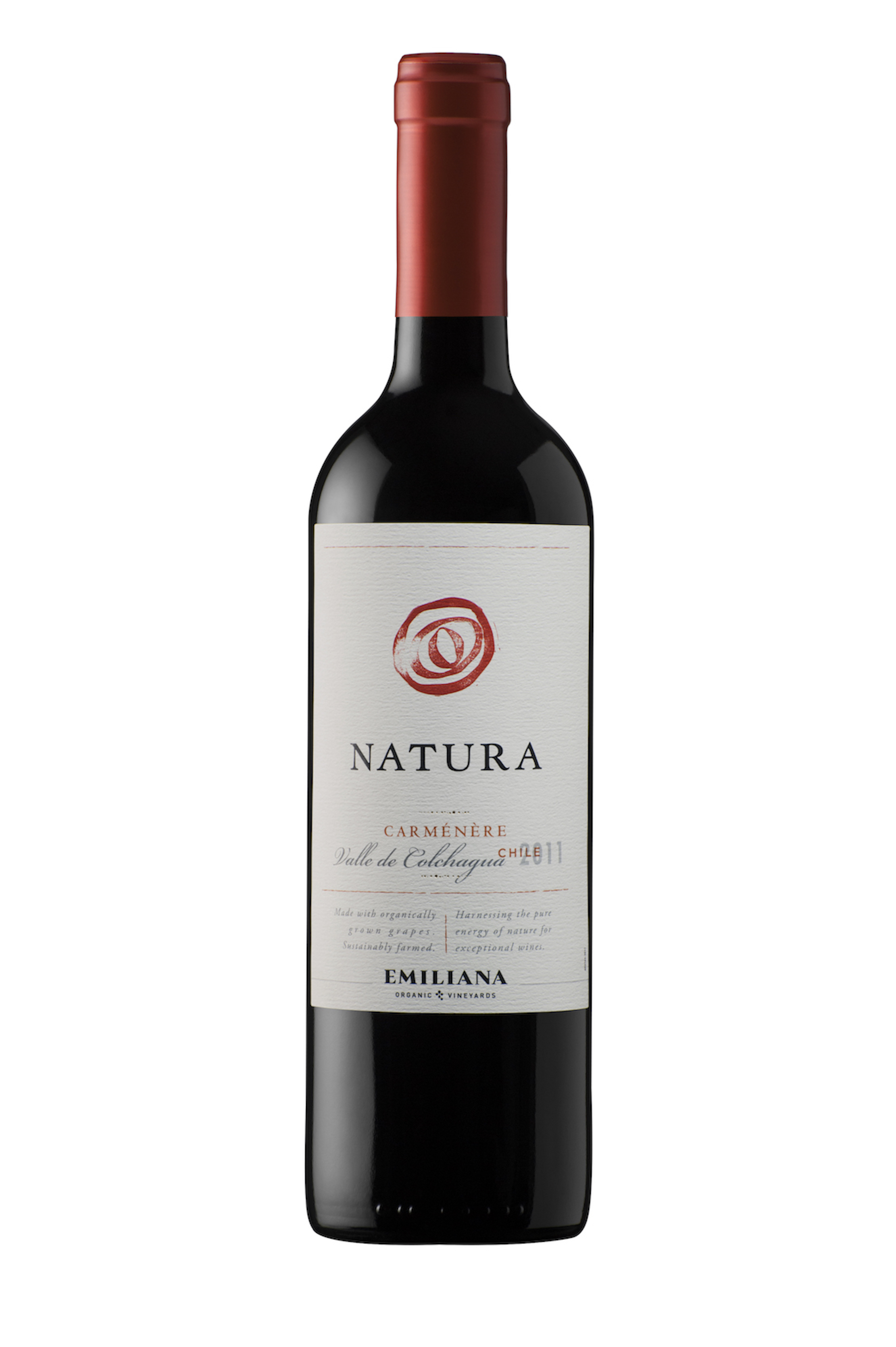 Biodynamic
farming adheres to the same principles, but takes it
one step further by relying on the cycles of the moon
and the sun to dictate much of what is done in the
field, and uses animal treatments such as compost
teas, horns buried with fertilizer, deer bladders, etc., to
treat the soil. It may sound a little hocus
pocus, but in reality it is very comparable to
homeopathic medicine, using the body’s (in this case,
the earth’s) own energy to heal itself.
Biodynamic
farming adheres to the same principles, but takes it
one step further by relying on the cycles of the moon
and the sun to dictate much of what is done in the
field, and uses animal treatments such as compost
teas, horns buried with fertilizer, deer bladders, etc., to
treat the soil. It may sound a little hocus
pocus, but in reality it is very comparable to
homeopathic medicine, using the body’s (in this case,
the earth’s) own energy to heal itself.
Emiliana has four distinct
collections of lovingly crafted organic wine now
available in the US – the base line of Natura, the
next step up in Novas, a stand-alone wine in Coyam,
and the ne-plus-ultra of bio-dynamic wines, Ge.
One taste of any of these and you too may find
yourself turning green – not with envy, but for a
newfound love of organic winemaking!
Recommended
– green wines for Summer:
Natura
Chardonnay In the cool coastal Pacific climate of the
Casablanca Valley, organically grown grapes are hand
picked during the last week of March, and vinified in
stainless steel tanks, free of the domineering
influence of oak. On the nose, tantalizing
citrus aromas of grapefruit and lime blend with notes
of pineapple, all of which reappear on the palate and
finish with balance thanks to the wine’s freshness and
natural acidity. Delicious with spring salads
and seafood dishes.
Natura
Carmenere – From the rustic isolation of the
Colchagua Valley, this intense and voluptuous offers
aromas of cherries, chocolate and spice, coming
together in ramped up volume on the palate with soft,
round tannins and firm, well-balanced structure.
Great balance between fruit and oak, with a long,
juicy finish.
Novas Sauvignon
Blanc Gran Reserva – Hailing from the San Antonio
Valley’s thin rocky and clay soils, the organic grapes
for this wine are harvested
by hand in March and undergo fermentation in stainless
steel to preserve their bright fruit character.
Herbal notes mixed with citrus and soft floral hints
fill the bouquet; the taste is medium bodied with
grapefruit flavors joined by a delicate acidity and a
touch of minerality.
are harvested
by hand in March and undergo fermentation in stainless
steel to preserve their bright fruit character.
Herbal notes mixed with citrus and soft floral hints
fill the bouquet; the taste is medium bodied with
grapefruit flavors joined by a delicate acidity and a
touch of minerality.
Novas Pinot
Noir Gran Reserva – The grapes for this wine are
grown in the cool, coastal Casablanca Valley’s
permeable sandy loam soils, and harvested by
hand. After a cold soak on the skins, the wine
is aged for 8 months in French oak barrels to add
character, depth and roundness.
Bright
ruby red in color with attractive aromas of berries,
strawberries and notes of spice and cocoa, this wine
bursts with fruit flavor, layered with earthiness.
Delicious with white meats, light sauces, full
flavored fish and shellfish, cured ham and sushi.
Coyam – A blend dominated by Syrah with nearly equal parts of Carmenere and Merlot balanced by “soupcons” of Cabernet Sauvignon, Mourvedre and Petit Verdot, from the Colchagua Valley estate called Los Robles – Spanish for the oaks, called “Coyam” by the native Mapuche people in their own language. Hand harvested certified biodynamic grapes are naturally fermented in French oak barrels. Coyam is largely unfiltered and aged for 13 months in barrels. Aromas of ripe red and black fruits integrate with notes of spice, earth and a hint of vanilla bean. Elegant expressions of fruit are delicately interwoven with oak, mineral and toffee.
Ge – Chile’s first certified
biodynamic wine, the name Ge is a nod to Geos, the
earthly environment pulling together all the elements
that surround us. Ge is a blend of nearly equal
parts of Syrah, Carmenere and Cabernet Sauvignon grown
in the deep soils of colluvial origin in the coastal
range, which lends mineral complexity. Naturally
fermented in oak barrels, Ge is deep plum red with
violet tones; it offers intense aromas of black fruits
and berries alongside mineral notes and a soft touch
of tobacco leaf. Generously fruity with cedar
notes, Ge is well balanced with tremendous volume,
well rounded tannins and a long finish.
For
more information please visit http://www.banfiwines.com/winery/emiliana/
Any of John Mariani's books below may be ordered from amazon.com.
 The
Hound in Heaven (21st Century Lion Books)
is a novella, and for anyone who loves dogs,
Christmas, romance, inspiration, even the supernatural, I
hope you'll find this to be a treasured favorite.
The story concerns how, after a New England teacher,
his wife and their two daughters adopt a stray puppy found
in their barn in northern Maine, their lives seem full of
promise. But when tragedy strikes, their wonderful dog
Lazarus and the spirit of Christmas are the only things
that may bring his master back from the edge of
despair.
The
Hound in Heaven (21st Century Lion Books)
is a novella, and for anyone who loves dogs,
Christmas, romance, inspiration, even the supernatural, I
hope you'll find this to be a treasured favorite.
The story concerns how, after a New England teacher,
his wife and their two daughters adopt a stray puppy found
in their barn in northern Maine, their lives seem full of
promise. But when tragedy strikes, their wonderful dog
Lazarus and the spirit of Christmas are the only things
that may bring his master back from the edge of
despair. WATCH THE VIDEO!
“What a huge surprise turn this story took! I was completely stunned! I truly enjoyed this book and its message.” – Actress Ali MacGraw
“He had me at Page One. The amount of heart, human insight, soul searching, and deft literary strength that John Mariani pours into this airtight novella is vertigo-inducing. Perhaps ‘wow’ would be the best comment.” – James Dalessandro, author of Bohemian Heart and 1906.
“John Mariani’s Hound in Heaven starts with a well-painted portrayal of an American family, along with the requisite dog. A surprise event flips the action of the novel and captures us for a voyage leading to a hopeful and heart-warming message. A page turning, one sitting read, it’s the perfect antidote for the winter and promotion of holiday celebration.” – Ann Pearlman, author of The Christmas Cookie Club and A Gift for my Sister.
“John Mariani’s concise, achingly beautiful novella pulls a literary rabbit out of a hat – a mash-up of the cosmic and the intimate, the tragic and the heart-warming – a Christmas tale for all ages, and all faiths. Read it to your children, read it to yourself… but read it. Early and often. Highly recommended.” – Jay Bonansinga, New York Times bestselling author of Pinkerton’s War, The Sinking of The Eastland, and The Walking Dead: The Road To Woodbury.
“Amazing things happen when you open your heart to an animal. The Hound in Heaven delivers a powerful story of healing that is forged in the spiritual relationship between a man and his best friend. The book brings a message of hope that can enrich our images of family, love, and loss.” – Dr. Barbara Royal, author of The Royal Treatment.
 |
The Encyclopedia of American Food and Drink by John F. Mariani (Bloomsbury USA, $35) Modesty forbids me to praise my own new book, but let me proudly say that it is an extensive revision of the 4th edition that appeared more than a decade ago, before locavores, molecular cuisine, modernist cuisine, the Food Network and so much more, now included. Word origins have been completely updated, as have per capita consumption and production stats. Most important, for the first time since publication in the 1980s, the book includes more than 100 biographies of Americans who have changed the way we cook, eat and drink -- from Fannie Farmer and Julia Child to Robert Mondavi and Thomas Keller. "This book is amazing! It has entries for everything from `abalone' to `zwieback,' plus more than 500 recipes for classic American dishes and drinks."--Devra First, The Boston Globe. "Much needed in any kitchen library."--Bon Appetit. |
"Eating Italian will never be the same after reading John Mariani's entertaining and savory gastronomical history of the cuisine of Italy and how it won over appetites worldwide. . . . This book is such a tasteful narrative that it will literally make you hungry for Italian food and arouse your appetite for gastronomical history."--Don Oldenburg, USA Today. "Italian
restaurants--some good, some glitzy--far
outnumber their French rivals. Many of
these establishments are zestfully described
in How Italian Food Conquered the World, an
entertaining and fact-filled chronicle by
food-and-wine correspondent John F.
Mariani."--Aram Bakshian Jr., Wall Street
Journal.
"Equal parts
history, sociology, gastronomy, and just
plain fun, How Italian Food Conquered the
World tells the captivating and delicious
story of the (let's face it) everybody's
favorite cuisine with clarity, verve and
more than one surprise."--Colman Andrews,
editorial director of The Daily
Meal.com. "A fantastic and fascinating
read, covering everything from the influence
of Venice's spice trade to the impact of
Italian immigrants in America and the
evolution of alta cucina. This book will
serve as a terrific resource to anyone
interested in the real story of Italian
food."--Mary Ann Esposito, host of PBS-TV's
Ciao
Italia. "John Mariani has written the
definitive history of how Italians won their
way into our hearts, minds, and
stomachs. It's a story of pleasure over
pomp and taste over technique."--Danny Meyer,
owner of NYC restaurants Union Square
Cafe, The Modern, and Maialino.
|
 |
 |
 |
 |
 |
 |
 |
 |
 Everett Potter's Travel Report:
Everett Potter's Travel Report: 
 Eating Las Vegas
JOHN CURTAS has been covering the Las Vegas
food and restaurant scene since 1995. He is
the co-author of EATING LAS VEGAS – The 50
Essential Restaurants (as well as
the author of the Eating Las Vegas web site: www.eatinglasvegas.
He can also be seen every Friday morning as
the “resident foodie” for Wake Up With the
Wagners on KSNV TV (NBC) Channel 3 in
Las Vegas.
Eating Las Vegas
JOHN CURTAS has been covering the Las Vegas
food and restaurant scene since 1995. He is
the co-author of EATING LAS VEGAS – The 50
Essential Restaurants (as well as
the author of the Eating Las Vegas web site: www.eatinglasvegas.
He can also be seen every Friday morning as
the “resident foodie” for Wake Up With the
Wagners on KSNV TV (NBC) Channel 3 in
Las Vegas.

MARIANI'S VIRTUAL GOURMET
NEWSLETTER is published weekly. Editor/Publisher: John
Mariani.
Editor: Walter Bagley. Contributing Writers: Christopher Mariani,
Robert Mariani, Misha Mariani, John A. Curtas, Geoff Kalish, Mort
Hochstein, and
Brian Freedman. Contributing Photographer: Galina
Dargery. Technical Advisor: Gerry McLoughlin.
To un-subscribe from this newsletter,click here.
© copyright John Mariani 2017

